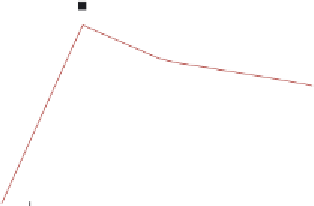Biomedical Engineering Reference
In-Depth Information
attempted according to
Hsu et al. (2009a,b,c
) to help enhance this electron relay (
Albareda-
Savant et al., 2000; Miscoria et al., 2006; Jia et al., 2007; Renedo et al., 2007; Kuwahara
et al., 2008
). The transducing elements that are in current use include carbonaceous materials
(
Lim et al., 2005
).
Hsu et al. (2009a,b,c
) have recently reported a simple process for
fabricating an amperometric glucose biosensor by inserting two barrel plating gold electrodes
onto an injection-molding plastic base. Herein, the authors' objective was to examine differ-
ent biosensing platforms to determine the one that would provide the most stability.
Figure 6.9
shows the long-term stability of the glucose SPCE biosensor based on the insertion
of barrel plating gold electrodes (
Hsu et al., 2009a,b,c
). A single-fractal analysis is adequate
to describe the binding kinetics. The binding rate coefficient (
k
) value is 6.868
1.982 and
the fractal dimension value is 3.0 - 0.5312. Note that the fractal dimension cannot have a
value greater than 3.0, thus only the negative error is given. If one were to take the liberty
of comparing the binding rate coefficient (
k
) values and the fractal dimension value obtained
from the long stability studies mentioned above with the previous studies shown for the
binding of different concentrations of glucose in solution to the disposable biosensor
(
Figure 6.8a-c
;
Lee et al., 2008
), it is seen that for long-term stability studies the fractal
dimension value is close to the maximum (max 3.0, values—2.88, 2.97, and 3.0) as compared
to the previous case and its binding rate coefficient (
k
) value is about four times less than that
of the disposable biosensor.
Liao et al. (2008)
have very recently developed a percutaneous fiber-optic sensor for chronic
glucose monitoring
in vivo
. Their biosensor is disposable, minimally invasive, and is capable
of monitoring the blood glucose level for several weeks. Their blood glucose sensor contains
a percutaneous fiber-optic that permits spectroscopic measurements of
the chemical
5
4
3
2
1
0
0
5
10
15
20
25
30
Time (day)
Figure 6.9
Long-term stability of the glucose SPCEbiosensor (
Hsu et al., 2009a,b,c
)
.





























